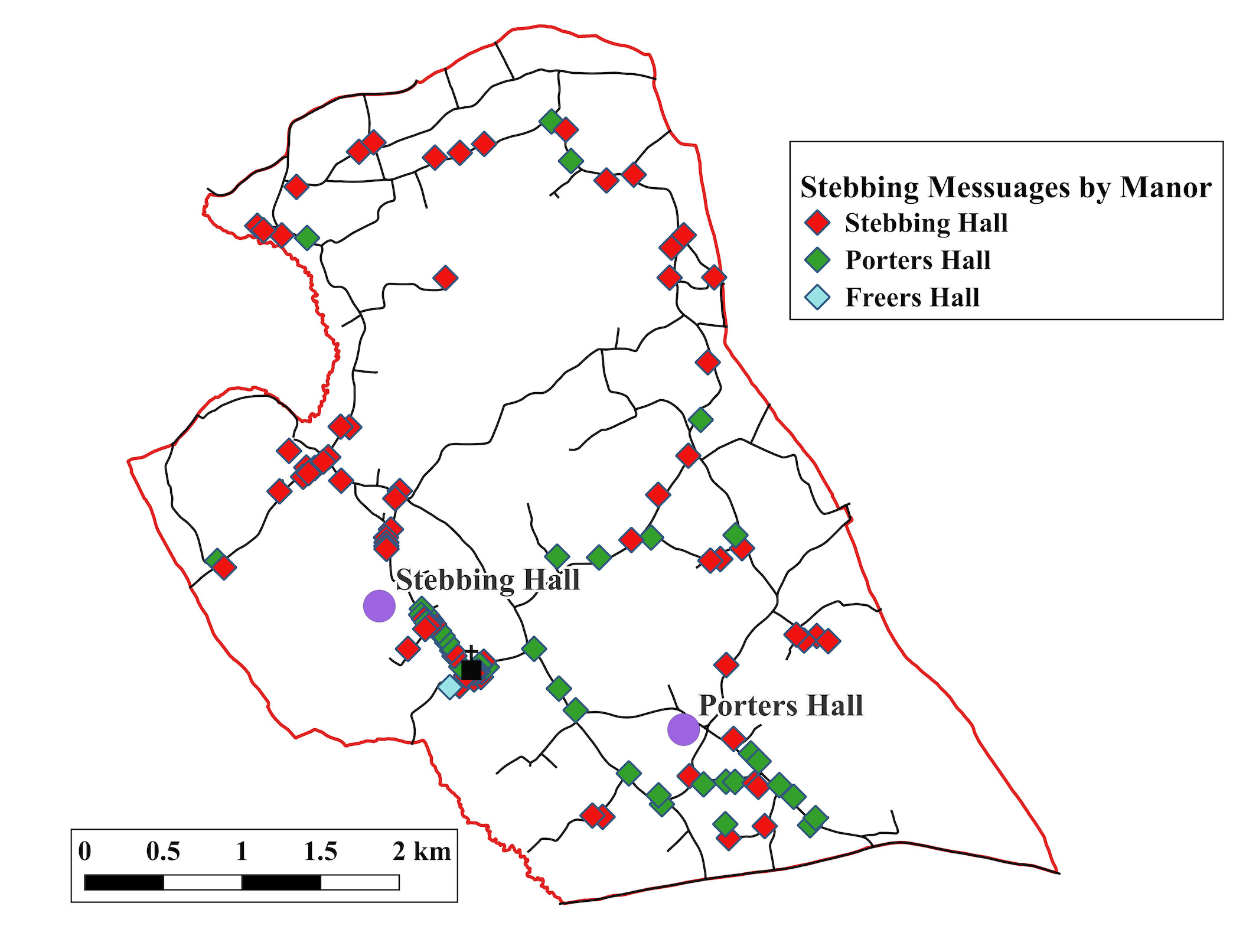Stebbing in 1381: Lordship, Rebels and Space
The 'People of 1381' team is very grateful to Lawrence R. Poos of the Catholic University of America for sharing with us this blog post drawing on his current project focussing on the village of Stebbing in Essex. Professor Poos is very well known for his work on rural society and manorial courts, and his monograph on A Rural Society after the Black Death: Essex 1350-1525 (Cambridge, 1991) and his articles on labour legislation enforcement and seigneurial jurisidiction are essential reading for anyone interested in the context of the rising of 1381.
Stebbing in 1381: Lordship, Rebels and Space
L. R. Poos
Deeply contextualised local studies of incident patterns and participants have been among the most important contributions to understanding the 1381 revolt (such as those by Dyer, Eiden, and most recently Xu). By closely tracing rebels, their victims, and the chronology and geography of acts of violence during the revolt, such research has made it possible to create collective profiles of participants’ backgrounds, and contributed to a more nuanced impression of the relative weight of anti-seigneurial or anti-manorial acts of reprisal on the one hand, and of actions aimed at publicly notorious figures in local and national government roles on the other hand.
What follows stems from a research project currently underway (in collaboration with Graham Jolliffe of the Stebbing Local History Society) relating to the village and parish of Stebbing, in north-central Essex, based upon manorial and other records, particularly a remarkably rich series of land surveys and rentals from the late thirteenth to the late seventeenth century. A primary aim of the project is to create a spatial reconstruction of Stebbing, based upon GIS (Geographical Information Systems) analysis. It aspires, in part, to explicate the meaning of space within the late-medieval and early-modern rural landscape. One early byproduct of this research is a suggestion that space at the parochial level mattered in understanding 1381.
The two principal manors in Stebbing during the late Middle Ages were Stebbing Hall and Porters Hall; there was a third, smaller rectory manor (Freers Hall), held by the Hospitallers. The early documentation for Porters Hall is rather more complete than for Stebbing Hall, and includes both rentals and surveys, and manorial court records spanning the entirety of the reign of Richard II and a few scattered years from Edward III’s reign.
The Porters Hall manorial court rolls constitute the sole record of actions by rebels within the parish in 1381. During the two sessions of the manorial court after the revolt (in November 1381 and July 1382), 7 entries (relating to 6 men and one husband-and-wife couple) recorded grants of the lord’s grace (for a fine) because those cited ‘came with the enemies of the lord king into the lord’s enclosure against his will, when the lord’s rolls were burnt’ (venit inter inimicos domini regis infra clausum domini contra eius voluntatem quando rotuli domini arsi fuerunt). The terminology implies direct accusation – that those in question participated in an incursion into Porters Hall’s moated manorial site and the burning of records – but action against these tenants did not, insofar as the entries make clear, entail seizure of tenants’ property.
In addition, 16 entries (6 men, 5 women, 5 husband-and-wife couples) were records of payment of fines to recover possession of land or other real property that had been ‘seized into the lord’s hands because of the uproar recently in the country’ (in manus domini seysita causa rumoris nuper in patria existentis). The terminology in these entries is less precise regarding specific allegation of rebellious action on the part of the tenants involved, and makes it unclear why these tenants were singled out for seizure and readmission, while nonetheless making it clear that they were involved in some way in the ‘uproar’.
Of the individuals appearing in these 23 entries, 13 can also be identified in the 1381 Stebbing poll tax return, and of those 13, 11 appear in the return with occupational or status designations:
Labourer 5 [laborarius]
Craftsman 3 (1 shoemaker [sutor], 1 butcher [carnifex], 1 carpenter [carpentarius])
Tenant 3 (2 free [liber tenens]. 1 servile [nativus tenens])
The People of 1381 database includes records of three Stebbing men who were accused of actions away from the parish. One of these was also among those named in entries in the manor court rolls (Walter Godyng, a butcher), who was a defendant (along with several other Essex men) in a case of trespass (nature and place unknown) brought by Sir Andrew Cavendish, son of the beheaded chief justice Sir John. Two more Stebbing men (not named in the manorial court entries) were charged in trespass for attacks on manors of Sir John Gildesburgh at Wennington and High Easter.
On the admittedly partial occupational evidence of the poll tax record, the Stebbing rebels conform to a pattern familiar from other studies: they were a mixture of craftsmen, relatively landless labourers, and a few more substantial tenants of whom some were holding land freely. Also familiar is the fact that some of the accused rebels held positions of local leadership: for instance, two (John Reve and Richard Ricoun) had been affeerers in the manorial court in the years before 1381, and at the next court session after the revolt, Ricoun – perhaps remarkably – was elected and sworn as Porters Hall’s reeve.
The Porters Hall manorial court in the late 1370s and very early 1380s reveal a smattering of instances of tenants accused of rent arrears, some though not all pertaining to those accused of participating in the rolls-burning. Only a couple of these cases related to servile incidents of tenancy, for instance labour services, and one noteworthy recurring feature of these disputes was appeals by several of those involved to an ‘old rental’: Henry Drane appealed that the ‘old rental’ be searched to determine the rent he owed (petit quod videatur per rentale quantum redditus), another entry claimed the demand for arrears of rent from Maud Lytle was justified by the ‘old rental’ (ut patet in antiquo rentali).
This is suggestive, for several reasons. A new rental was drawn up for Porters Hall in December 1383. Its creation soon after the revolt might also indicate that the ‘rolls’ that were burnt included the ‘old rental’ (thus making the new one necessary). As noted above, some rolls of the Porters Hall manor court dated before 1381 escaped destruction and are still extant; whether this is because they were not in accessible locations during the rebels’ incursion, or because the rental was identifiable and the specific target of attack, is simply impossible to know. The new rental may have been intended to resolve any ambiguities arising from the uncertainties implied in the arrears-of-rent cases, or – alternatively – to reinforce the manorial lord’s claims to services owed. In the 1383 rental, 8 (possibly 9) of those cited by the manorial court as 1381 rebels held tenancies that entailed labour services, a benchmark of servile tenure, and in the years following the revolt the Porters Hall court recorded a few instances of tenants withholding labour obligations (one of them among those charged as 1381 rebels). Incidents of serfdom, then, were still a reality of Porters Hall before and after the revolt (indicating that this manor lagged behind the pattern of relatively rapid eclipse demonstrated for England generally by Bailey) and disputes over them continued (insofar as the record implies) at a muted level.
The lord of Porters Hall during the revolt was Sir William Wauton. He held considerable properties, other manors, and lands in Essex (Willingale Doe, West Thurrock, Thaxted, and Broomfield, among others). He had also acted as JP in peace sessions in the late 1370s – where numerous fines for violating the Statute of Labourers were imposed – and he was part of the commission to collect the 1377 poll tax and the commission to investigate shortfalls in collection of the 1380-1381 poll tax, the latter of course the immediate spark of the revolt’s outbreak. Moreover, the Essex lawyer Clement Spice – a victim of attacks on his property both in the countryside and in London during 1381 – acted as conveyancer and feoffee to use (including Porters Hall itself after Wauton’s death in 1393). Wauton fits the category of a victim of rebel attacks very publicly identifiable with despised local government and in particular two chief grievances against such officials, the polltax itself and enforcement of the Statute, as well as an apparently close connection to a lawyer targeted by rebels elsewhere. However much intra-manorial tensions over tenurial terms may have weighed in provoking the attack on Porters Hall, Wauton’s public notoriety was obvious.
The ‘new’ 1383 Porters Hall rental is just one of a long series of detailed land surveys that make it possible to map properties in both the principal Stebbing manors in the late Middle Ages and beyond. Map 1 (below) displays the locations within the parish’s boundaries of all known Stebbing late-medieval messuage sites, displayed by the manor to which each belonged. As this map shows, messuages (as were individual fields and other properties) were intermingled between the two manors: more Stebbing Hall to the north, more Porters Hall to the south, but with many outliers against this division.

Map 1. Stebbing messuages by manor in the later Middle Ages
It is possible to map the messuages – and by presumption, though without absolute certainty, the residences – of most of the accused 1381 rebels of Stebbing with high degrees of confidence based upon the 1383 rental. (More elaborate mapping, of different types of property, is in progress but unlikely to result in very different visual patterns.) Map 2 (below) displays the results of this exercise.

Map 2. Stebbing rebels’ messuages, 1381
The rebels, by this showing, clustered tightly around the site of Porters Hall manor house itself, where they entered the lord’s close (infra clausum domini), rather more tightly than the dispersed patterns of all Porters Hall messuages spread across the parish. The tentative suggestion that this project would offer, then, is that space and location mattered in local acts of violence of the sort that repeated itself across the county of Essex and beyond. If invasion and rolls-burning were the culmination of deeply seated resentments smouldering against targets who were both manorial lords and notorious public figures, the immediate impetus – collective psychology impelling to specific violence – was bounded by geographical space. The example of Stebbing suggests that when grievances turned to action and word spread of impending attack, all this took place in a neighbourhood that was not simply an undifferentiated expanse of territory, but rather within an immediate, small area – many of the residences nearly literally next door to one another – where a call to attack in the heat of a moment could be immediately heard and replied to.
Further reading:
Mark Bailey, The Decline of Serfdom in Late Medieval England: From Bondage to Freedom (Woodbridge: Boydell, 2016)
Christopher Dyer, ‘The social and economic background to the rural revolt of 1381’, in The English Rising of 1381, ed. R. H. Hilton and T. H. Aston (Cambridge: Cambridge University Press, 1984), pp. 9-42
Herbert Eiden, ‘Joint action against “bad” lordship: The Peasants’ Revolt in Essex and Norfolk’, History 83 (1998), pp. 5-30
Christopher Starr, Medieval Lawyer: Clement Spice of Essex, Essex Society for Archaeology and History, Occasional Papers, New Series, 2 (2014)
Mingjie Xu, ‘Analysing the actions of the rebels in the English Revolt of 1381: The case of Cambridgeshire’, Economic History Review 75 (2022), pp. 881-902
The court rolls and rentals discussed are in the British Library:
British Library Add. Roll 65983: Porters Hall, manorial court rolls, 1377-1399
British Library Add. Ch. 65957: Porters Hall, manorial rental, 1383






